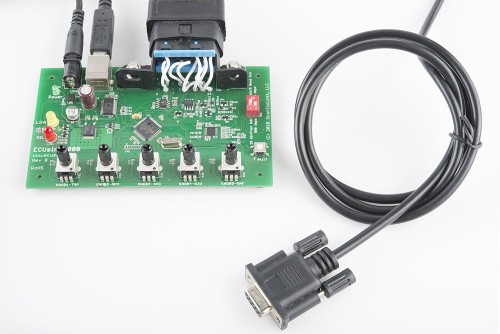Understanding the On-Board Diagnostics II (OBD2) system is crucial for anyone working on modern vehicles, especially General Motors (GM) cars and trucks. While OBD2 is a standardized system, different manufacturers, including GM, utilize specific communication protocols within this standard. Knowing these Gm Obd2 Protocols is essential for accurate diagnostics and effective repairs. This guide will delve into the protocols you’ll encounter when working on GM vehicles, ensuring you’re equipped to communicate effectively with their onboard computer systems.
GM, like other automakers, has employed a range of OBD2 protocols over the years. These protocols dictate how diagnostic tools communicate with the vehicle’s Engine Control Unit (ECU) and other modules. Initially, GM favored the SAE J1850 VPW protocol, but has since transitioned to the more universally adopted ISO 15765 CAN protocol in newer models. Recognizing which protocol a GM vehicle uses is the first step in any diagnostic process. Let’s break down the key protocols relevant to GM vehicles.
SAE J1850 VPW: The Legacy GM Protocol
Variable Pulse Width Modulation (VPW) under SAE J1850 was a common protocol in older GM vehicles. If you’re working on a GM vehicle manufactured before the mid-2000s, especially models from the 90s, it’s highly likely to use J1850 VPW. This protocol communicates at 10.4 kbps and is characterized by its unique pulse width modulation scheme to transmit data.
| SAE J1850 VPW | |
|---|---|
| Feature | Description |
| BUS + | Pin 2 |
| 12V | Pin 16 |
| GND | Pins 4, 5 |
| Bus State: | Bus idles low |
| Maximum Signal Voltage: | +7V |
| Decision Signal Voltage: | +3.5V |
| Minimum Signal Voltage: | 0V |
| Number of bytes: | 12 |
| Bit Timing: | ‘1’ bit -HIGH 64uS, ‘0’ bit -HIGH 128uS, Start of Frame – HIGH 200uS |
Key identifiers for J1850 VPW in GM vehicles include the presence of pin 2 in the Diagnostic Link Connector (DLC) as the BUS+ line. While less common in modern vehicles, understanding VPW remains valuable when dealing with older GM models.
ISO 15765 CAN: The Modern GM Standard
The Controller Area Network (CAN) protocol, standardized as ISO 15765, has become the dominant OBD2 protocol across the automotive industry, including for GM vehicles manufactured in recent years. Mandated in the US for all vehicles from 2008 onwards, CAN offers higher communication speeds and greater flexibility compared to older protocols. GM vehicles from the mid-2000s onward increasingly adopted CAN, and it is now the primary protocol for diagnostics.
| ISO 15765 CAN | |
|---|---|
| Feature | Description |
| CAN HIGH (CAN H) | Pin 6 |
| CAN LOW (CAN L) | Pin 14 |
| 12V | Pin 16 |
| GND | Pins 4, 5 |
| Bus State: | Active when CANH pulled HIGH, CANL pulled LOW. Idle when signals are floating. |
| CANH Signal Voltage: | +3.5V |
| CANL Signal Voltage: | +1.5V |
| Maximum Signal Voltage: | CANH = +4.5V, CANL = +2.25V |
| Minimum Signal Voltage: | CANH = +2.75V, CANL = +0.5V |
| Number of bytes: | L |
| Bit Timing: | 250kbit/sec or 500kbit/sec |
For GM vehicles using CAN, you’ll find communication happening over pins 6 (CAN High) and 14 (CAN Low) of the DLC. The transition to CAN in GM vehicles reflects the industry-wide shift towards faster and more robust communication networks within automobiles.
 OBD2 ECU Connector and Diagnostic Tools for GM Vehicles
OBD2 ECU Connector and Diagnostic Tools for GM Vehicles
An OBD2 ECU simulator and diagnostic tools, commonly used for testing and understanding GM vehicle communication protocols.
Why Understanding GM OBD2 Protocols Matters
For mechanics and automotive enthusiasts working on GM vehicles, understanding these protocol nuances is more than just technical trivia—it’s a practical necessity.
- Diagnostic Tool Compatibility: Different protocols require compatible diagnostic tools. Knowing the GM OBD2 protocol ensures you use a scanner or interface that can correctly communicate with the vehicle’s computer. Using an incompatible tool can lead to communication errors or an inability to access diagnostic data.
- Accurate Data Interpretation: While OBD2 provides standardized diagnostic trouble codes (DTCs), the way data is transmitted and interpreted can be protocol-dependent. Understanding the underlying protocol can sometimes be crucial for advanced diagnostics and troubleshooting complex issues.
- Legacy Vehicle Service: As older GM vehicles remain on the road, familiarity with protocols like J1850 VPW is essential for shops and individuals who service these cars. Ignoring protocol differences can lead to misdiagnosis or failed repairs.
Conclusion: Protocol Knowledge is Key for GM Diagnostics
Navigating GM OBD2 protocols is a fundamental skill for anyone involved in servicing or modifying GM vehicles. While the automotive world has largely moved towards CAN, the legacy of J1850 VPW in older GM models means technicians need to be versed in both. By understanding these protocols and their specific implementations in GM vehicles, you can ensure efficient, accurate, and effective diagnostics and repairs, whether you’re working on a classic muscle car or a modern SUV.